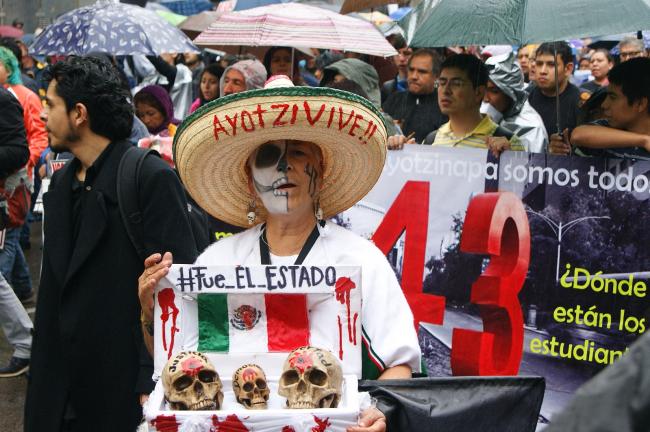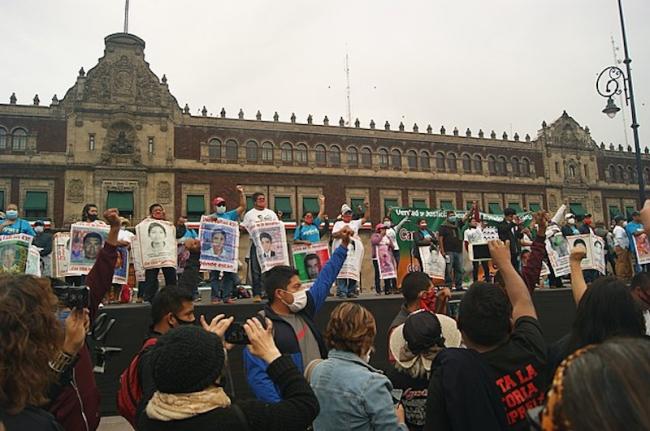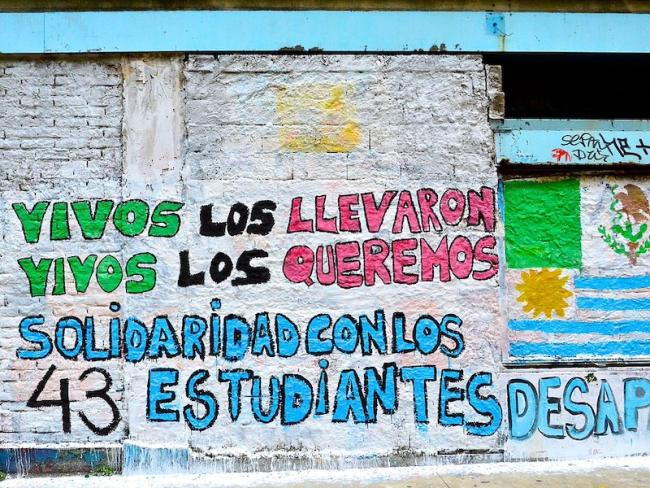
A slightly longer version of this article was published in Spanish in Este País on September 23, 2024.
On the night of September 26-27, 2014, in the city of Iguala, Guerrero, hundreds of municipal, state, and federal police, Mexican soldiers, and some employees of the illegal transnational heroin trafficking enterprise known as Guerreros Unidos collaborated to attack five buses that had been commandeered by students from the “Raúl Isidro Burgos” Rural Teachers’ College of Ayotzinapa. They also attacked—by mistake—a sixth bus carrying a youth soccer team from Chilpancingo, Los Avispones, as well as several cabs driving on the same road.
During the seven-hour attacks, the police stopped all the buses, shot at a small press conference given by the students, killed six people, seriously wounded dozens, and disappeared 43 students from Ayotzinapa. The police, military, and civilian perpetrators used their cell phones to coordinate with each other. The Army monitored and documented the entire operation in real time through the C4 video surveillance system, illegal wiretapping of Guerreros Unidos employees, the presence of at least two military infiltrators among the students (one of whom disappeared with them that night), the presence of military intelligence agents at the different scenes of attack, and constant patrols by soldiers from Iguala’s 27th Battalion between these locations.
That September 2014 night in Iguala, state security personnel at all levels attacked, killed, and disappeared the students. Then, the Army—including then Defense Secretary Salvador Cienfuegos, then 27th Infantry Battalion Captain José Crespo, and the officers and troops involved—lied about and concealed the documentation they had. The administrative structure of the state—a mayor, a governor, a president, a secretary of defense, a secretary of the navy, an attorney general, a secretary of the interior—lied, tortured, covered up, invented, hid, and disappeared.
In that long night of terror, a whole decade of terror began. The government of Enrique Peña Nieto invented a false story—the incineration of the 43 students during a single rainy night at the open-air Cocula garbage dump, a fiction self-styled as the “historical truth”— to close the case.
Over the past 10 years, two supposedly opposing governments have lied and continue to lie about the events that led to the disappearance of the 43 Ayotzinapa students. One way to understand this eagerness to obscure the truth is to recognize that, in Iguala that night, a crack opened up, revealing the hidden face of the state.
The Betrayal
Andrés Manuel López Obrador said he was different. He said his commitment was to the people and, as a presidential candidate in 2018, he made an explicit commitment to the families of the 43 missing students. He promised to find the students and the truth of what happened that night, and to punish those responsible, no matter who they were.
His first act as president was to establish the Commission for Truth and Access to Justice in the Ayotzinapa Case (COVAJ) under the command of then Undersecretary of the Interior Alejandro Encinas. During his first year in office, the Attorney General's Office established the Special Unit for the Investigation and Litigation for the Ayotzinapa Case (UEILCA) and appointed Omar Gómez Trejo, a human rights lawyer with years of experience in the case and support from the families, as special prosecutor.
At the request of the families of the 43 disappeared students, López Obrador also invited the Interdisciplinary Group of Independent Experts (GIEI) to return to the country to provide technical assistance in the investigation, almost four years after its elegant expulsion at the hands of the Peña Nieto administration.
By 2020, then, there were three different bodies, all with unfortunate acronyms, investigating the attacks against the students, the disappearance of the 43, and the series of crimes related to four years of torture and lies that the previous government used to construct the “historical truth.” The three agencies shared information and carried out certain joint procedures, interviews, and searches.
There were important advances in the investigation. Investigators obtained videos from the former Center for Investigation and National Security (CISEN) showing personnel from CISEN, the Attorney General's Office (PGR), the federal police, and the Navy participating in torturing people detained in 2014 in relation to the case. They obtained videos from a Navy drone that had documented the federal government carrying out dubious acts, hidden until then, at the Cocula garbage dump on October 27, two days before the supposed discovery of the site. They obtained text messages from Guerreros Unidos, intercepted by U.S. authorities in Chicago, documenting the relationships between the illegal heroin trafficking enterprise, the Mexican Army, different police forces, and various public officials.

They also obtained testimonies from witnesses involved in the events who, despite mixing truths and lies, provided information that checked out with the other evidence in the case, expanding the documentation of the participation of soldiers, officers, police, and officials in crimes against humanity. With the testimony of one of those implicated, investigators found two small bone fragments of two students about a kilometer from the Cocula garbage dump—a different location than where the previous government’s narrative placed the remains. And they obtained, within the Army's own archives, military documents that simultaneously showed the Army’s unlawful actions; the degree of documentation that the military produced in real time before, during, and after the night of the events; and the years-long string of lies they had told about it.
In 2021, important advances were made in the investigation. The GIEI and UEILCA were confident about the possibilities of getting to the bottom of the case. It seemed that, for the first time, state institutions—with an unprecedented level of international technical assistance—would succeed in investigating and clarifying a state crime, a crime against humanity committed and then covered up by a large network of police, soldiers, and public officials from various institutions. It seemed that, for the first time, an official investigation led and carried out by a group of young Mexicans who believed in the rule of law and the President López Obrador’s commitment, would manage to clearly reveal a hidden and terrifying dimension of the state.
But that was not the case. Just when the investigation began to yield evidence of Army, Navy, and CISEN involvement, the López Obrador government took action to halt the advances, divert the investigation, remove all the prosecutors and investigators who had made progress on the case, and ultimately kill the investigation.
On Monday, August 15, 2022, the president, the attorney general, the secretary of the Interior, the president of the Supreme Court, the undersecretary of human rights, and the president of COVAJ had breakfast together. At that table, they all agreed to seal up the crack in the state’s mask that had revealed how soldiers and employees of an international heroin trafficking company killed and disappeared rural college students; how police, soldiers, and public officials lied and inflicted torture to erase the traces of the disappearance; and how state institutions lined up to sustain the lies.
A month and a half after that breakfast, the Army was still lying and had not turned over all the documents in the case; the former attorney general was arrested (he’s now back at his home in Mexico City’s affluent Lomas neighborhood); a secret and unverified COVAJ report featuring falsified screenshots attempted to cement the narrative of the events; the families were forced to listen again to a false and horrifying narrative about the fate of their children; the special prosecutor was removed from the case and, a little later, so was his entire team; and 21 arrest warrants against military and other public officials were cancelled, only for 18 of them to later be reissued.

In October 2022, two of the four members of the GIEI resigned in protest. In July 2023, the other two published a sixth report and left the country, denouncing the political interference in the case, the Army’s lies, and the impossibility of continuing the investigation. The UEILCA was left in the hands of an old friend of the president with no experience in cases of forced disappearance or human rights, who dedicated himself to convening dance classes in the prosecutor's office. The COVAJ was forgotten, delegitimized. From his morning press conferences, the López Obrador supported the Army's lies and insulted the GIEI, the former special prosecutor, and the lawyers of the families of the 43 disappeared students.
Going Down in History
It would be one thing to try to solve the case and fail: to underestimate the power of silence that protects the relationships between the security forces, the justice system, and international traffickers of illicit substances. It would be one thing not to dedicate the necessary resources to the investigation, not to give fair support to the investigators, not to take into account the complexity of the case or the degree of complicity of people still active in institutions close to the current government. It would be one thing to fail.
But that is not what happened. With the Ayotzinapa case, the government of Andrés Manuel López Obrador did something very different: it conspired, falsified, and lied to stop the investigation. The administration did the same with the National Search Commission. And it did the same with the truth commission on human rights violations committed between 1965 and 1990.
In speeches first at the Hilton Hotel and then in the Zócalo after his election win on July 1, 2018, López Obrador said at several points, “I want to go down in history as a good president of Mexico.” And in that, I believe, he was honest. But no. He will go down in history as the president who betrayed his word, betrayed the families of the disappeared, militarized the country, consolidated his party’s power, and, like all his PRI and PAN predecessors, safeguarded above all the hidden face of the Mexican state.
John Gibler is the author of four nonfiction books about politics in Mexico including I Couldn’t Even Imagine that They Would Kill Us: An Oral History of the Attacks Against the Students of Ayotzinapa (City Lights, 2017).

